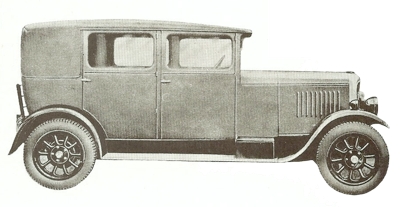Bean
|
1919
- 1929 |
Country: |
 |
|
THE UNPRECEDENTED demand for cars after World War 1 inspired many manufacturers, whose munitions contracts had come to an end with the Armistice, to move into this potentially lucrative field.
Some floated ambitious companies with projected production figures that were, even in those car-hungry days, blatantly over-ambitious and among these was the Staffordshire firm of A. Harper, Sons & Bean Ltd, established in 1826 as metalworkers.
With the coming of the motor age, they had built up a considerable business in stamped, forged and cast components, while, during the war, they concentrated on shell manufacture. Their 1919 plans for motor manufacture included an initial output of 50,000 cars - 20,000 more than the capability of the English branch of the Ford Motor Company, who were, at that time, Britain's largest manufacturer.
In May 1919, to eliminate development costs, the company bought the jigs, tools and designs of the 11.9 hp Perry light car, of which around 700 had been built between 1915 and 1916. At the 1919 Olympia Motor Show in November, the public had their first chance to see the new 11.9 hp Bean - in fact, only a mild reworking of the Perry - which was available at a chassis price of £325, as a two-seater for £425, or as a four-seater for £450.
Within a few months, the price of the four-seater had risen to £650. A new parent company, Harper Bean Ltd, capitalised for £6 million, had been formed, controlling the activities not only of Bean but also of Vulcan, Swift, the Hadfield Steel Company, Birmingham Aluminium Castings and a dozen lead-ing component and coach-work manufacturers.
The aim was to create a British equivalent of General Motors, completely self-sufficient British Motor Trading Corporation, but its career was short and chequered. Bean production was spasmodic; in January 1920, 100 were built. By February the figure was up to 125 and in March, the works at Tipton were capable of turning out 20 cars a day.
Sales were not up to expectation and internal differences were wrecking the BMTC, which, by 1923, was selling only the imported Mathis and Cleveland cars. In a desperate bid to save the situation, aggravated by the collapse of the post-war boom, Bean copied the lead of Henry Ford in America and slashed their prices viciously in an effort to boost sales.
The four-seater was now only £545 and competitive with the popular Morris-Cowley; but sales didn't improve, and the cruellest blow of all came early in 1921 when William Morris cut the price of his cars and watched the sales graph soar. By the end of 1921 Bean were in serious trouble and were not even represented at the November 1921 Motor Show. Harper Bean Ltd withdrew their support, and a receiver was appointed. The parent company's shares were bought by John Harper Bean and the receiver was withdrawn in April 1922.
By now, the company had become distinctly less ambitious, and all thoughts of vast mass-production were abandoned. Instead, Bean aimed at the solid middle-class market, diverging from their one-model policy in November 1923 when the new Fourteen was announced. It was an enterprising design for the period, with dual ignition and four-wheel braking available as optional extras. It was also competitively priced, at £395 for a five-seat tourer (the 11.9 four-seater was £345 at that period), which put it in the same class as the Austin 12.
The Fourteen, being strongly made and reliable, was used by Francis Birtles (from Australia) for many of his celebrated trans-continental drives, but despite such proofs of its capabilities, the Fourteen failed to save the slipping fortunes of its manufacturers. In 1926, John Harper Bean resigned to join Guy Motors, leaving Hadfields in sole charge. For 1927 they introduced a new model, with a 2.7-litre, six-cylinder engine and a new, squared-off
radiator to replace the rounded cooler of the eariier models.
 The Bean Fourteen Forty Fabric Safety Saloon. The Bean Fourteen Forty Fabric Safety Saloon. |
The new Hadfield-Bean was a lemon, prone to sudden and disastrous big-end failure.
A larger, 3.8-litre six was hastily developed for the untapped Colonial market, but proved to be even worse. Birtles drove the
prototype across Europe and Asia as far as Hindustan, at a cost of several sets of back axle gearing.
Old Scrap Iron
By the time he arrived in India the car, now rechristened 'Old Scrap Iron', was in an advanced state of dereliction. The Bean Imperial Six was quietly axed from the production schedule. Now under the management of H. Kerr Thomas, President of the Institution of Automobile Engineers, Bean Cars Limited (the new title dated from the 1926 reorganisation) proceeded with a thoroughly eccentric marketing policy.
At the 1927 Olympia show, they announced the new Fourteen-Forty ('
entirely new design, superb coachwork in dual tones') at £325 for a tourer, but continued production of the old Fourteen alongside it. As the older model cost less (£295 for the long-chassis tourer) and carried the same £14 road-tax on a larger engine (2.9-Iitres), sales of the new model were bound to suffer. In any case, the 14/40 was yet another loser. Its power unit was no more reliable than that of the 2.7- litre 18/50 hp Six (which was taxed £4 more than the larger 14), and its worm-drive rear axle and poorly laid-out
brakes wer.e among the other trouble points.
Nevertheless, the old Fourteen had gone twelve months later; mercifully, so had the six, but even the new 14/70 Hadfield sports chassis, with Dewandre servo-assisted brakes, high-compression engine and raised rear axle ratio, could not save the company, and, in 1929, Bean stopped car production altogether. Their commercials, which had been produced along- side the cars since 1924, fared a little better, but in 1931 these were also abandoned and the company reverted to its former status as a component manufacturer.



